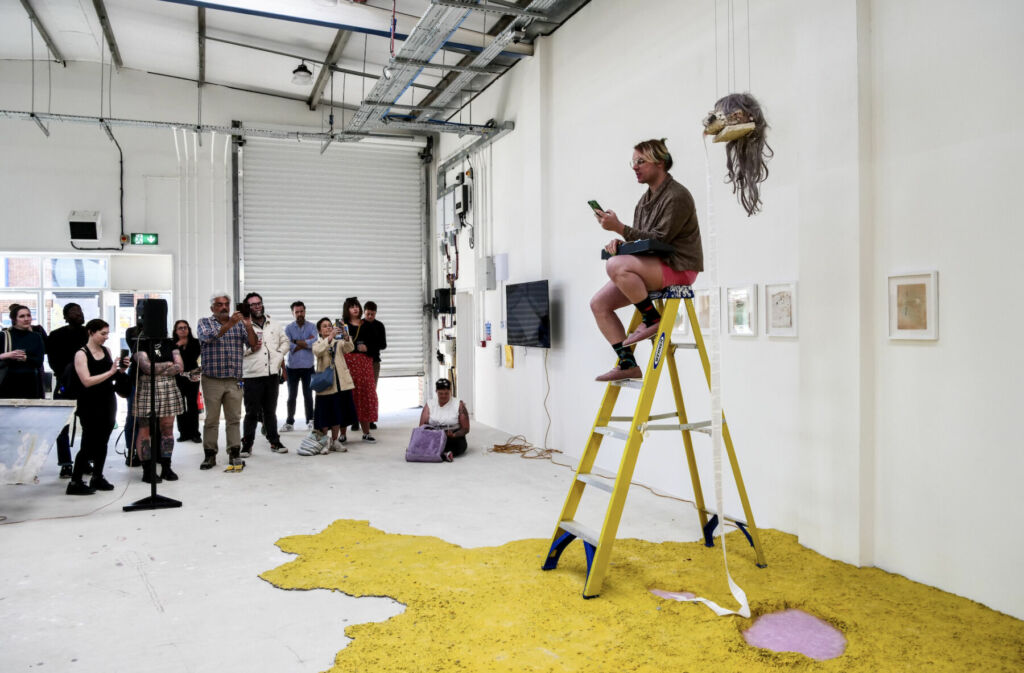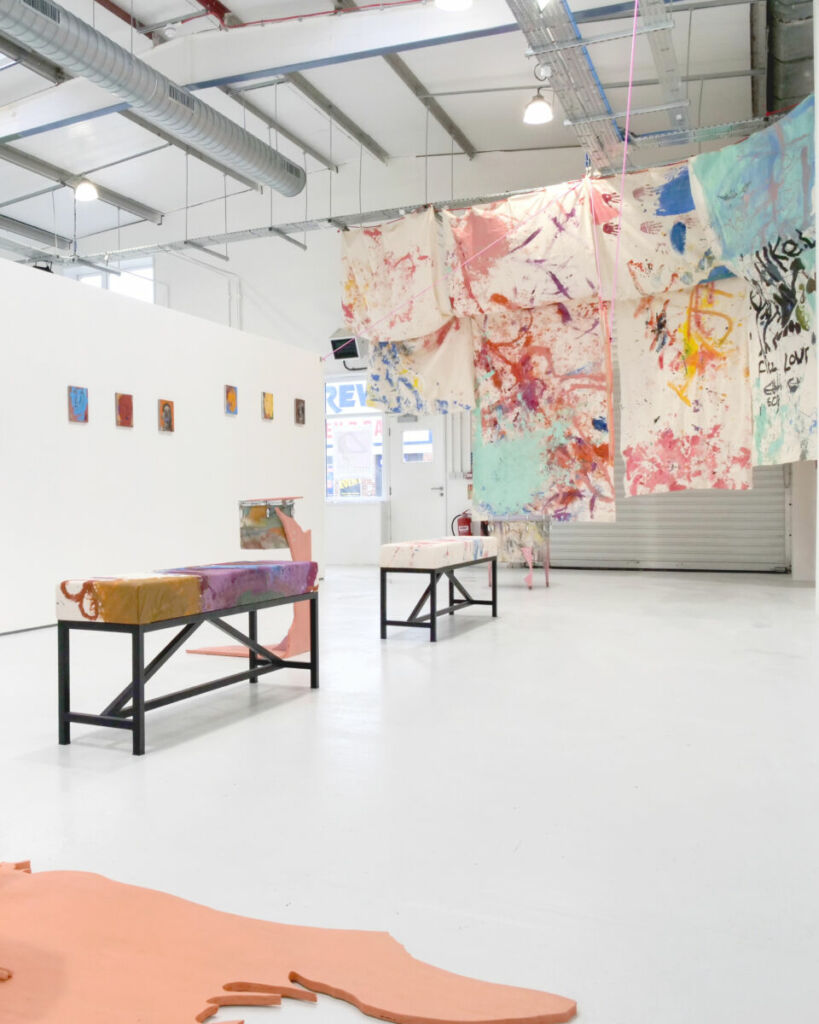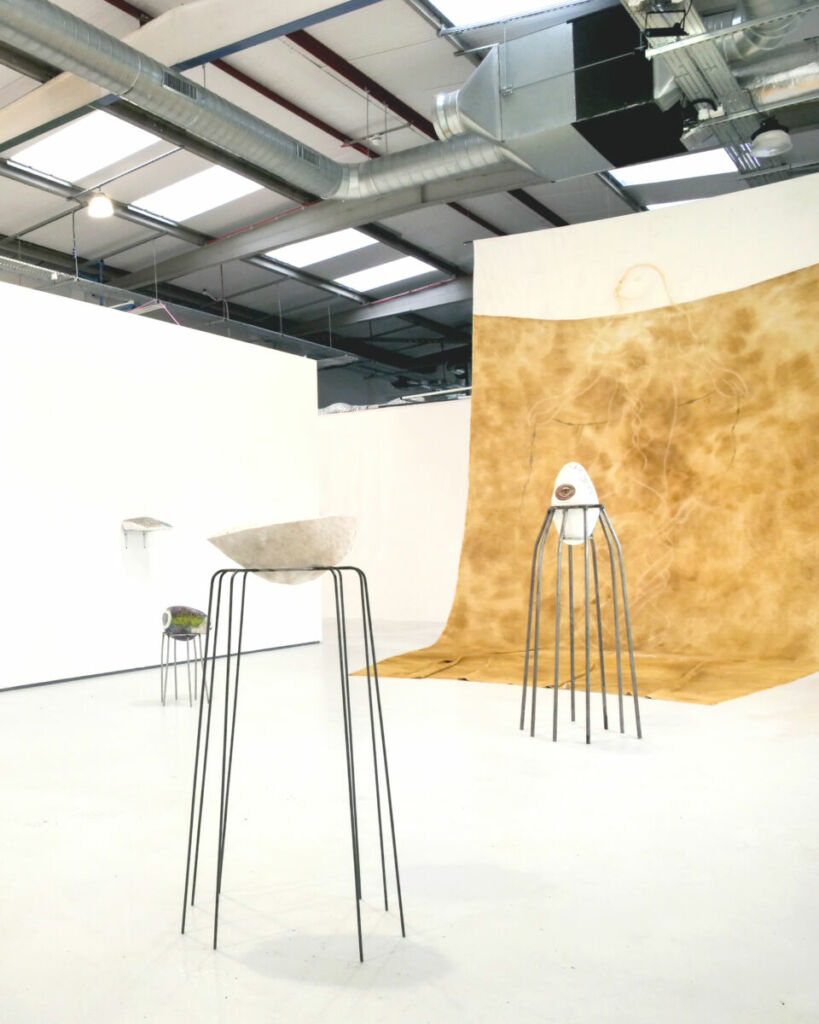Text by Charlie Clark

The South East coastal art scene has been particularly burgeoning over the past few years. With Margate rapidly becoming the new Hackney, it seems like the capital’s art community is quickly getting tired of the City’s rising prices and competitive gallery scene, and setting their sights on the seaside towns of yesteryear. Margate, Deal, Folkestone, and Hastings all contain growing artistic communities attracting talent from London and beyond.
Further West along the coast from the historic city of Hastings, with its flourishing art scene and illicit occult community lurking in the shadows, is the small seaside town of Bexhill-On-Sea. On a chilly winter afternoon, I took a winding bus journey from St Leonard’s Warrior Square and found myself there. The bus dropped me off right outside the coastal art scene institution, the De La Warr Pavilion, nestled just off the beach with stunning views out to sea. After a brief visit to Angelo Madsen Minax’s brilliant show on queer love and intimacy, I made my way to Flatland Projects’ new space, which only recently opened in April last year.
Previously based in the world’s largest underground BMX park in Hastings, Flatland Projects now sits in the small town of Bexhill-On-Sea. Flatland takes its name from its previous location, as ‘Flatlanding’ is a form of artistic cycling, like breakdancing but on a BMX. Ben Urban, Flatland’s Director and co-founder, says that the project took its name from this as part of their mantra as an organisation is to be constantly adapting and shapeshifting to their community and environment.
In a commercial market where many galleries and arts organisations are having to rigidly define themselves based on concrete USPs and buzzwords, it’s a refreshing take on space-making and one that is very much needed in an art world whose commitment to the idea of community can often be skin deep. Now based in Bexhill-On-Sea after receiving a grant from the local council to set up shop in a set of units there, Flatland Projects is continuing its commitment to making future-proof, sustainable spaces for exhibitions, workshops and artist studios.
Support from a council committed to seeing the flourishing of its local grassroots culture means a lot in a town where many young people set their sights on bigger cities, never to return to the small towns and villages they grew up in. Urban says that a lack of creative infrastructure for young people to return to is one of the things he aims to change through Flatland.
As the southeast coast becomes a hotspot for artistic communities, Urban notes that the inevitable rising prices will mean that many of these students will be unable to return to the towns they grew up in. With Flatland, they aim to create a space that generates an exciting and relevant art scene in the area, whilst at the same time providing affordable studio spaces to those who need them.
A recent report from We Industria on artists’ pay and working conditions in the public sector is an exposé into the systemic exploitation of artists who often perform unpaid or underpaid labour whilst bolstering and supporting the cultural economy of the UK. The testimonies in the report is based on also demonstrate how this structural issue weighs heavily on those from less privileged backgrounds, who are forced to take on multiple jobs, often leaving artistic pursuits behind due to poor mental well-being or financial instability.
In response to this crisis and as a part of their ‘future-proofing’ strategy, Flatland considers what investments will ensure the most long-term engagements with the artists that they support. Cautious not to fall into pricey commercial rental structures, Flatland offers artist studios at a subsidised cost, in line with the local area’s commitment to growing its grassroots art culture.
As part of a long-term support strategy, Flatland has also developed an ‘early career’ studio programme, that focuses on collaborative learning and community engagement, with the goal of providing its participants with the skills necessary for sustainable art practice.
Community workshops and education are a big part of what Flatland is about, feeding back into Urban’s ideas on reclaiming the creative ecology of the area, as led by the people who grew up there. Urban himself, along with co-founder Billy Stanley (Operations Director of the project), grew up in Hastings before moving to London to study Fine Art at Goldsmiths University.
Inspired by the student scene in South East London, he wanted to bring some of that same DIY, eclectic spirit back to his home town, which in so doing would also open up avenues for other artists and students to return there and build their art practices. Collaborating with local community groups and colleges embeds the art infrastructure that Flatland Projects aims to build locally. Such collaborative work should be what these institutions strive for. To quote writer Lola Olufemi, in her contribution to the We Industria report,
The only way that we can make art mean anything is to create conditions where its production could be scattered, various, generative, and spontaneous. Freely made, resourced and explored by all […] Art made for each other; for mutual benefit with no promise of reward, remuneration, genius, fame or institutional recognition.
Flatland’s strategy is a means towards creating such conditions of production, building an inclusive programme with its roots in local community hubs, as well as its own community-focused gallery. This is a space for art-making, rather than just final products, where experimentation and exploration are encouraged.
Spaces like this can fill you with a kind of practical hope about the future of art-making, a future where collaboration and process are centred, over individual achievement and objects on pedestals under spotlights. This hope was resoundingly present in one of Flatland’s latest exhibitions. ‘The Spinners’ by Richard Phoenix, one of Flatland’s early career residency artists, took its name from the 1657 painting by Diego Velàzquez.
The painting captures the collaborative and communal nature of traditional textile-making, where groups of women would often gather to spin, weave and create fabrics together. Phoenix’s exhibition was a celebration of ‘the spinners’ in a contemporary sense, a celebration of those who organise, facilitate and hold space for creating and making. With over a decade’s experience in creative support work, Phoenix has experienced first-hand the inspiring and generous work of those in the support sector.
Working with the Glyne Gap Faculty in Bexhill, a school for kids with severe learning disabilities, Phoenix has created a minimal and open space, exhibiting the collaborative work done with the students there alongside his own joyful paintings inspired by care workers he has met. The energetic paintings show figures engaged in a range of activities, as well as cut-outs suspended by an elastic rope that bounce up and down in the space.
This contributes to the heady sense of playfulness throughout the show. With benches and drums sparsely installed in the space, Phoenix left plenty of room to invite peers, collectives and communities to spend time there and play music and make art.
A large canvas sheet is suspended from the ceiling to the left of the show’s entrance. Turning the
corner you see is covered in large colourful splashes of acrylic paint, some handprints, some
stickmen, and bits of text like “Frez” and “Love”. This piece made collectively with the Glyne Gap
students, once again becomes a reference to the Velàzquez painting, having been made collaboratively just as Velàzquez would have collaborated with his assistant and other members of his workshop.
Phoenix’s collective approach, also seen in the painted canvases covering the drums and the benches, reminds us of the workshops and guilds of art history. Such a return to these collaborative-making practices is exciting. It also recalls the DIY methods of the punk scene, which Phoenix also has roots in, having worked as a musician in punk bands since he was a teenager.
This turn to collective forms of making is mirrored in the 2021 Turner Prize nominees, who were all collectives, as well as the work of contemporary artists like Hannah Quinlan and Rosie Hastings whose collaborative practice is also inspired by medieval guilds where artwork and crafts were produced as part of a collective process. For this set of shows, Flatland’s project space was split into two, with a dividing wall separating Phoenix’s show from Miroslava Večeřová’s, also one of Flatland’s early career residency artists.


Večeřová’s show, titled ‘Our View is Mineral’, delves into the relationship between the natural and the human world, building sculptures and installations out of locally sourced materials such as sandstone, limestone, and cuttlefish ink. Mirroring the large canvas in Phoenix’s show is a huge drawing on linen hanging from floor to ceiling, and draping along the floor. The drawing depicts a seal-human hybrid, with a line at the neck suggesting a watery surface that divides the hybrid-bodied creature into human and seal.
The seal’s head rests above whilst a human body with lobster claws for hands and long eels for feet lies underneath. The zoo-morphing figure hints at the unknown watery worlds beneath the ocean’s surface. We rarely think about the fact that only one-fifth of all biomass exists on land, whereas the rest lies underwater. The deepest trenches of the oceans can exceed 10000 meters in depth, with sunlight rays reaching only the first 300m of these depths. Beyond this, it is only the bioluminescence of deepwater species that lights up the darkness. And recently many contemporary artists, and blockbuster moviemakers, have been exploring these lesser-known worlds.
Večeřová’s interest in these underwater spaces aligns with an onto-epistemological tendency of feminist work to think ‘with’ rather than just about matter, bodies, and material. Feminist art and theory often take material, fleshy bodies as a central point of concern, and here, Večeřová’s centring of unknown water worlds draws on material feminism’s critique of the epistemological ideal of ‘total’ knowledge. Meaning, rather than making an attempt to know all there is to know about underwater ecologies, the artist sits alongside the oceanic, letting its shapes and forms show themselves to her, which she then transforms into sculptural work. Her installation for the Flatland’s show is a colourful imaginary of these ecologies that exist in and around oceanic bodies.
The video work, ‘Our View is Mineral’ shows the artist moving in response to her oceanic surroundings, set amongst the local cliffs. Moving so close to the water demonstrates Večeřová’s ‘thinking with’ method whilst also drawing on a hydrofeminist position responding to the idea that we contain bodies of water and can therefore connect with oceans, rivers, and lakes.
This web of reciprocity is central to the artist’s work. It is present in the artist’s choice of materials, which are collected from the beach and converted into sculpture. The sandy and chalky colours draw us back to the tidal zone and sit as evidence of the deeply felt relationship the artist has with this place.
The coloured fossils that are dotted throughout the show have glassy eyes embedded within them, speaking to the liveliness of the ancient stones. Placing these glassy-eyed stones amongst the zoomorphic, hybrid creatures, Večeřová moves us past hydro feminism’s ideas of bodies of water and towards a ‘petrofeminism’ of ‘bodies of stone’, reminding us of the weighty bones that hold our bodies upright. The calcite in the stones is also the calcite inside of us. The artist does not make an attempt to make these non-speaking materials speak. Instead, she respects the materials for what they are, presenting them in the space, and situating them as oceanic elements within the web of things.








